Day 1. Torrevieja to Ainsa, Spanish Pyrenees
Distance – 666km
The May trip had been a washout, so after two weeks drying out in the Spanish coastal town of Torrevieja (home) I had returned for a 2nd crack at the Pyrenees. It’s now June and it’s finally proper hot. I’d ridden up the coast from Torrevieja to a wonderful little town called Aínsa with its ancient walled citadel.
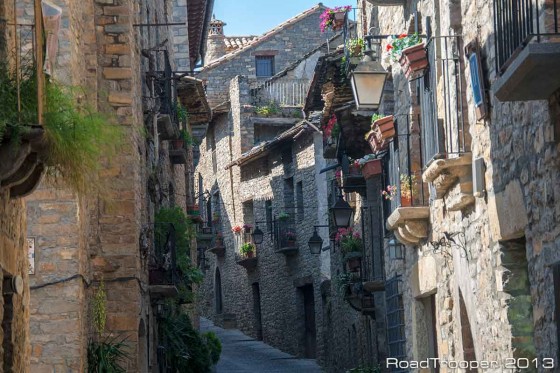
Ainsa Street
Situated 96km north east of Huesca the regions capital, Aínsa, according to its legend, was founded in 724 by Rey Garcí Ximénez after a vision of a burning cross. Such visions were very fashionable at the time – as was eating ill-advised mushrooms I guess.
The historical fact is that the Castillo de Aínsa (Aínsa Castle) dates back to the 11th century and formed part of the defence network on the borders of the Christian territories. The local Christians of the time were royaly pissed off and constantly arguing with the land pilfering Moors to the south.
The fact that these Christian locals were decedents of land pilfering Visigoths was not lost on the Basques to the West who were pissed off at everyone, Christian and Muslim alike. In fact it was the Spanish Visigoths constant warring with the Basques that led to the Visigoths bankruptcy which allowed the Moorish invasion in the first place. Suffice to say, this area is littered with little fortresses and a fascinating history which also includes Celts, Romans, Greeks, Phoenicians, Templars and of course the Carthaginians.
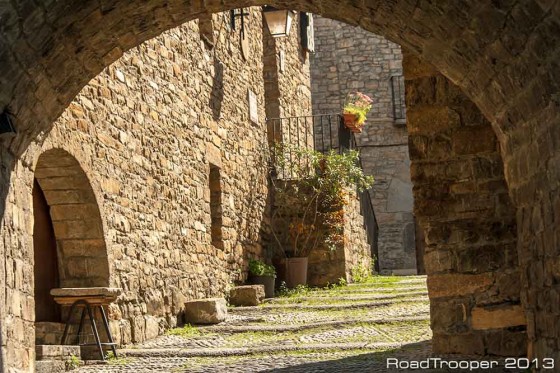
Aínsa
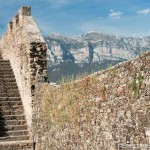
Aínsa fortified walls
This town is a right little gem to say the least. The only real way to see it is by foot, so I’d booked 2 nights in the Hotel Meson de L’Ainsa. The hotel itself is unfortunately lacking in any form of character. That said, the staff were friendly, my room was small but spotlessly clean, the buffet breakfast was all you can eat, and there was secure covered parking for the bike. And being an easy walk to the old town with its bars/restaurants it’s a good spot for the lone biker for a night or three. There are plenty more hotels in and around the town to suit all pockets.
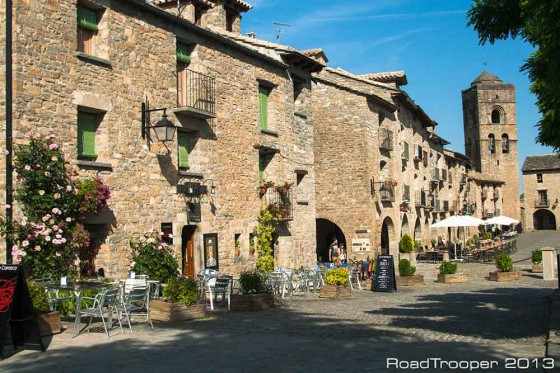
Town square
I would have thought such a beautiful town would be jam packed with tourists, but on the 12th of June 2013 it was almost deserted. This gave me a wide choice of hassle free dining, and to top it all off I found a great little gin bar also offering a cool pint of Guinness of all things. Guess where this Irishman spent his nights during his visit.
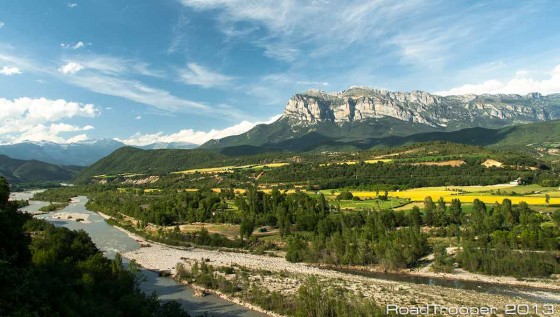
View from Aínsa…
Carlos the owner is an all round nice guy and good to have a chat with if you’re on your own and stocks a great choice of non typical local beers.
I love such places as it’s places like this where you can chat with the locals and get tips for good roads/routes you would not normally find by maps alone. The Pyrenees beer here I’d also highly recommend, not too much though as some brew’s are bloody rocket fuel.
www.facebook.com/abrevadero
www.abrevadero.com
Day 2. Aínsa, N, D, and Forest Track Route.
Distance – 40km
I was absolutely gagging to get the F800GS into a more challenging environment. I’d had a slight taste of it on Irelands West Coast in April. And another morsel on an emergency access “road” which ran through flooded farmland while escaping a motorway pileup south of Brodeaux in May. I’d bought the 800GS specifically for this reason; I wanted to explore roads and tracks my previous R1150RT would not take me.
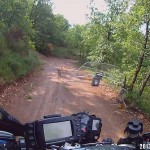
Ainsa Mountain Road
After consulting the night before with a couple of likely looking local trail riders, I’d been recommended to try some of the local forest tracks where motor biking is allowed. Strictly speaking “true off-roading” is generally not allowed in Spain (see footnote at end for clarification on trail riding in Spain). And definitely not in their highly protected national parks which make up the lions share of the Pyrenees. There are a few good reasons for this off-road ban, protecting increasingly rare wildlife and the risk of starting fires (exhaust sparks) being amongst them.
Unfortunately this is the closest to the actual route I took that Google Maps will show as it does not include tracks… http://goo.gl/maps/3uyRg
After all the rain the track that begins in the hilltop village of Laspuna was as slick as it gets even though the mud was not particularly deep in most sections. It was of that thick, glutinous red terracotta kind that would clog up any normal tyre turning them to slicks in no time. I suspect even my previous tyre (Metzler Tourance) might not have coped. Luckily I would not have to find out as I’d chosen a set of Anakee 3′s before leaving Ireland which seemed to shed the muck and find grip in the ooze with ease.
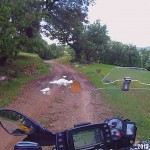
Fun in the mud…
It was a messy, tortured and awkward ride due to my inexperience on mudded tracks, but the main problem I had was with the heat and 100% humidity in the forest sections. I was flooding sweat at an alarming rate. But for a good 2 hours I was like a kid again playing in the mud, covered in shit and thoroughly enjoying the experience.
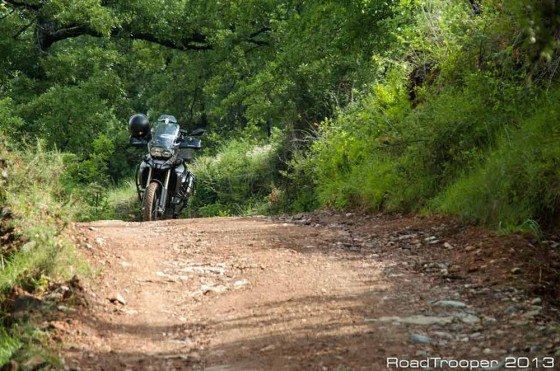
Ainsa Trails
Now I really see why so many love this type of riding. I also realised I’d really found the perfect bike for me, while it’s far from perfect at anything, it’s damn good at almost everything, and, more to the point, it makes me feel like there is nowhere I can’t go.
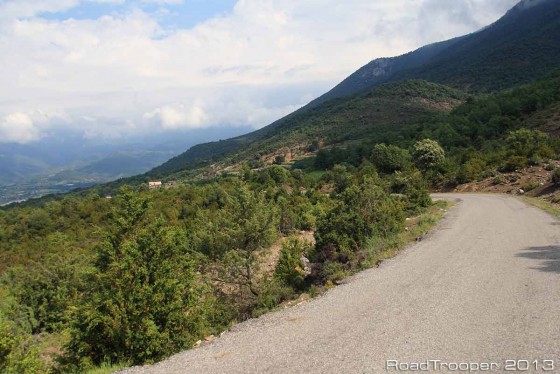
Back roads near Ainsa
This route was not all mud and forest track as it leads onto some interesting back roads with wonderful scenery.
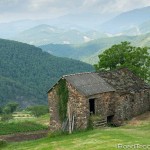
View near Ainsa
I can’t help thinking what the hotel owner thought as I pulled into the hotel car park that evening, both rider and bike covered in dark red mud, but he gave me an appreciative nod either way. The local Spanish around the Pyrenees are far more used to bikers than the Spanish further south where big bikes are still relatively rare. The car park was now sporting 2 brand new 1200GS’s and a new F800GS, the fact they were spotless and sparkling newness in the warm summer sun only helped to show my bike up as a right looking knacker. It only increased the smile on my face though, it had been a good day ![]()
Trail riding and off-roading in Spain
Now, before I get a herd of emails telling me that you can of course go off-roading in Spain. Spain is actually one of the best places in Western Europe for off-roading, but let me just clarify. The Pyrenees is famous for its tracks & trails where you can of course ride, but the key words here are “tracks & trails”. These are mainly ancient by-ways, farmers or shepards trails or impossibly old roads to long dead settlements and villages. Many are also pilgrim trails, Camino de Santiago de Compostella routes of which there are many. Many more are old smuggling trails leading to/from France, many of which you can ride too. However, riding off trail “true off-roading” can lead you into serious trouble, especially in the National Parks, and rightly so. Many of the tracks & trails are open to all vehicles, but due to the amount of hikers and wildlife the speed limit is 30kmph. If you think there is nobody about to enforce that limit you’d be wrong too as the Guardia Civil who are responsible for rural areas, smuggling and emigration have posts throughout the Pyrenees.
It should also be noted that in July and August many areas have a fire risk status. This means you can not ride there without a permit or a legitimate guide, and groups of riders are limited to 3, sometimes 5, with a 10 or 20 minute break from the next group. In the driest season there is commonly a total ban on all vehicles due to the fire risk. This is all a “general” guideline. Spain is made up of autonomous states, so the Navarra region will have slightly different rules from Aragon or Catalonia for example.
Do your research before you go, the regional Spanish tourist boards are a good place to start. I get my info from asking the locals at the bar/hotel etc of where I’m at. If they don’t know they have always put me in touch with a local bike club where the best info is always had. There are also countless books availaible on Amazon with tracks and trails listed all over Spain. Failing that, just book a guided tour, there any number of great Pyrenees off-road tours to choose from which are ideally the best place to get started before doing it on your own and easily worth the money.
Don’t worry about the language barrier, the Spanish working in the tourism industry in the Pyrenees region tend to be bi- or trilingual with English, French and German commonly spoken. Remember too it’s not just the Pyrenees where great off road riding can be found. There are many sections of the Camino de Santiago that can be ridden on a motorbike, large areas of Asturias, the Picos and countless points between Barcelona and Malaga are open to off roading.
Again, I have always found that contacting local bike clubs in the area you want to ride are by far the best source of info. More often than not you may well be invited to join them for a ride out. I’ve yet to contact a bike club that does not welcome a visit from a foreign rider, if only to show off their best local roads or tracks so don’t be shy. And if it’s your first time visiting a new country a visit to your local tourist board of that country before you go can prove absolutely invaluable. Tourist boards are also a great source for scoring free maps, many of which are motorbike route specific.
Day 3. Ainsa to Banesque via Cañón del Congosto de Ventamillo
Distance – 140km
I can’t overstate how many times I have been put onto the discovery of great roads simply by talking to locals. It was at a roadside smoke break as I was nearing Ainsa a few days before that I happened to have a chat with a couple of 1200RT mounted Guardia Civil officers. They’d pulled into the lay-by just after me, at first I’d thought “oh here we go again as I got ready to bend over and produce my documents ready for inspection”.
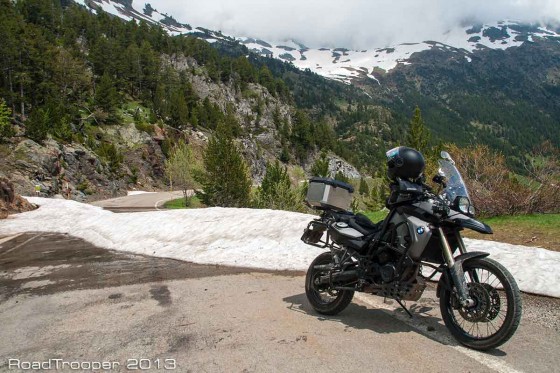
Upper road, Benasque Valley
As it turned out they’d just fancied a break and were simply “bike curious” about me and my 800GS. We actually had very typical every-day bikers road-side chat to which they really seemed to appreciate the fact I ignored their uniforms and side arms and talked as one biker to another. Interestingly they understood completely why I’d exchanged my own RT for the little GS as one had a GS himself while the other had a KTM.
Long story short they highly advised me to check out the Benasque Valley for good photos and a cracking good ride. On the map Benasque simply looks like a dead end road which it is and so was never on my radar, that and the fact that I’d never heard of it.
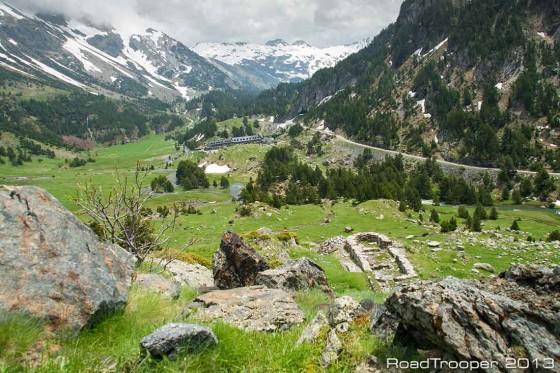
The Benasque Valley
So my 2nd morning in Ainsa saw me ride south out of town on the N-260 towards Campo where some serious fun began. Just north of Campo the N-260 runs along the Rio Esera and the Cañón del Congosto de Ventamillo.
This stretch of road is a twisty joy but can be highly dangerous due to at least 15 blind corners, the narrow road itself and the amount of trucks and 18 wheelers. Check out the video to see what I mean.
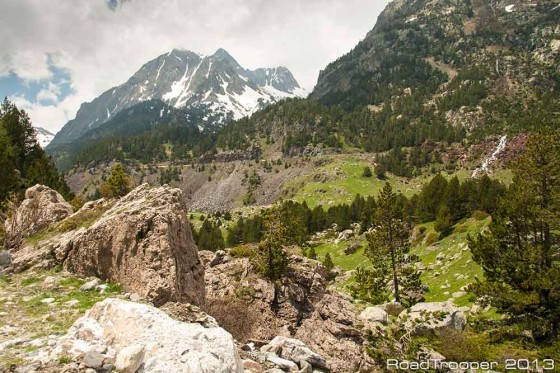
Benasque
At Castejón de Sos I joined the A-139 and rolled up to the small and pretty town of Benasque. This is a perfect place to stretch the legs or have lunch. Continuing north out of town the road then enters the Benasque Valley, a place of staggering beauty.
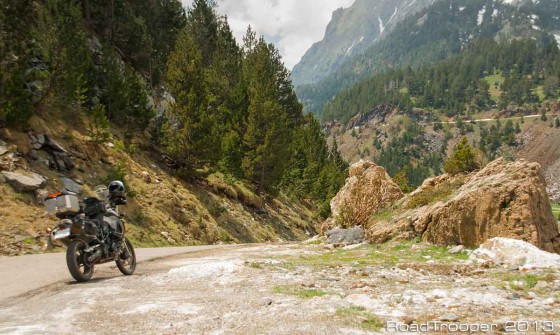
Trail road behind the hotel in the Benasque Valley
Like I said it’s a dead end and about 10km up the road forks into 2 dead ends. Taking the high road to the left brings you up to some magnificent views.
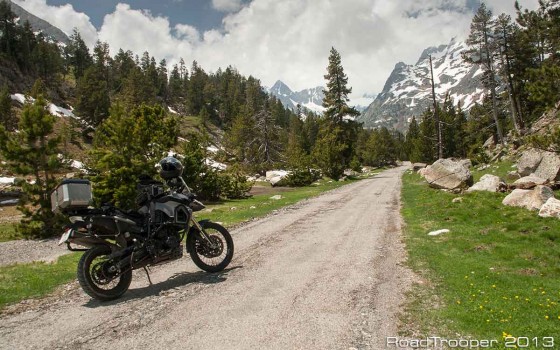
Trail road behind the hotel in the Benasque Valley
The lower road brings you to a hotel in the lower valley and just past the hotel is a rocky dirt track leading further into to valley which is most definitely GS territory. This valley is definitely worth exploring for the scenery alone.
Day 4. Ainsa to Montory via A-1604, Val de Anso & Col de Pierre St Martin
Distance – 227km
The morning of day 3 saw me starting my day stuffing as much into my face as the buffet table at Hotel Meson de L’Ainsa would allow. I was on my 2nd shift at the buffet when a lad comes up and asks in a curious accent if I’m the RoadTrooper guy? Eh, yea say’s I wondering where this chat was leading. Turns out him and his 2 mates, all originally from Israel were touring the area using routes from the RoadTrooper website and were on those 3 shiny BMW’s I’d seen outside making my bike look like a stinker. The 3 lads, originally school mates were now living well apart with one in Holland, one in the US and the other still in Israel. But once a year they meet up in a new country, rent bikes and have a laugh for a week or so. How cool is that?. This year they had flown into Madrid a few days back and rented the bikes in Madrid – only 4hrs ride south of the Pyrenees. A good option if one is short on time or living a long way off.
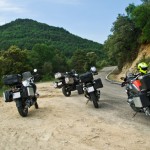
The A-1602 west of Ainsa
A bit of crack was had while breaking bread on round 3 of the buffet and the 3 lads decided to tag along with me for the day, the more the merrier say’s I. We take the popular smooth and swift N-260 west out of town, but just after Boltana we cross the bridge and take the A-1604, a more deserted and interesting scenic mountain road more suited to bikes with good suspension. Eventually emerging onto the N-330 just south of the unpronounceable town of Sabiñánigo we head through Jaca then taking the A-1602 right as we approach the medieval hilltop town of Berdún. Berdún, occupied since Celtic-Iberian times, during the “Pax Romana” is worth a visit if you have the time but this time we ride on.
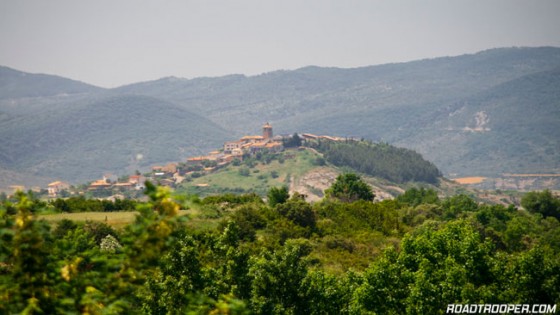
Berdún
But we push on as the A-1602 leads through the Valle de Ansó, an area seemingly lost in time and impossibly picturesque as this road leads through Aragon and into the Roncal Valley. Do yourself a favour and stop off for lunch in the medieval town of Ansó and walk it off along it’s ancient streets.
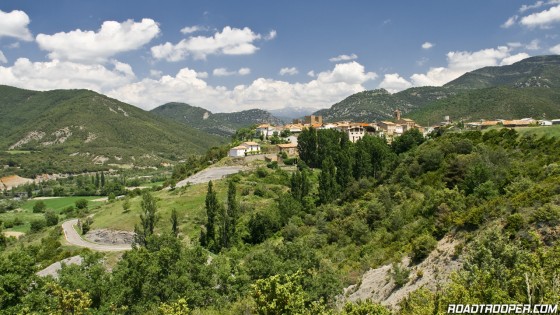
Binies
We however chose to take a break at the 9th century village of Binies simply to take a look at the castle there, which was for sale if anyone’s interested. Put this road on your list folks, and if you can factor in the time to see all it has to offer if you’re into the sightseeing thing!
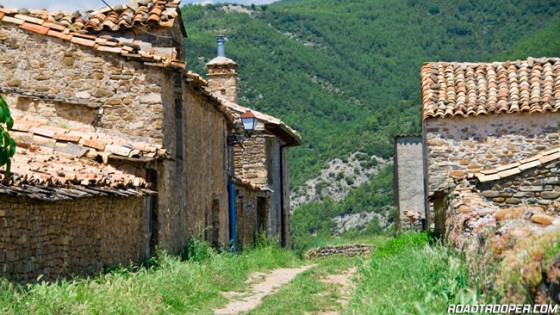
Binies, a place lost in time like so much of this area and all in a good way.
From Ansó the A-1602 becomes the NA-176 which starts in bad shape, but as soon as we cross the regional border into Navarre the road transforms from caterpillar to butterfly.
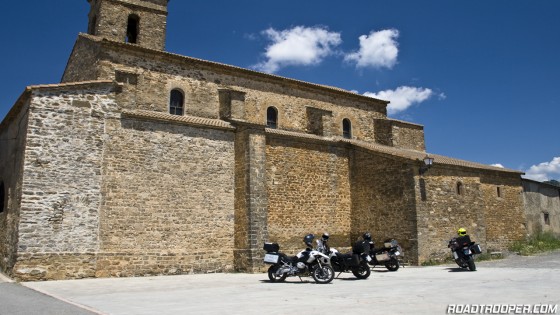
Binies
This silky smooth twisty joy gets our tyres melting before dropping into the Roncal valley taking a right to join the NA-137 and riding into Roncal.
The 176 is a beauty as you glide through the Roncal valley passing old villages, each one worth a visit. On exiting the village of Isaba about 1km keep your eye out for the ancient Romanesque bridge to the right.
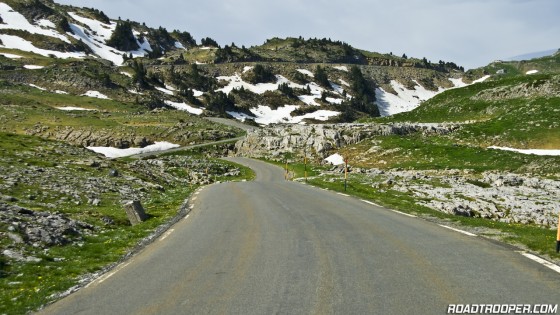
Col de Pierre Saint Martin
From here it’s a straight 15km run into France over the epic Col de Pierre Saint Martin, one of the 5 star passes in Europe in my book and something reminiscent of a James Bond car chase involving exotic cars and even more exotic scantily clad women. No exotic women to be found here though, just bikes and blokes in leather. And so, in the spirit of NWA’s immortal and slightly controversial rap song “Fu*k the Police” we get our heads down and let loose the Germanic horses to take poor ‘ol St Pierre at speed…….

One of the greatest joys being a biker is meeting people from all over the world with the same passion.
To round off a perfect day we inevitably end up sinking Basque beer in the French village of Montory’s Auberge de l’Etable’s wonderful little bar where I attempted to give my new Israeli friends a lesson in drinking “Irish style”. Oh dear ![]()
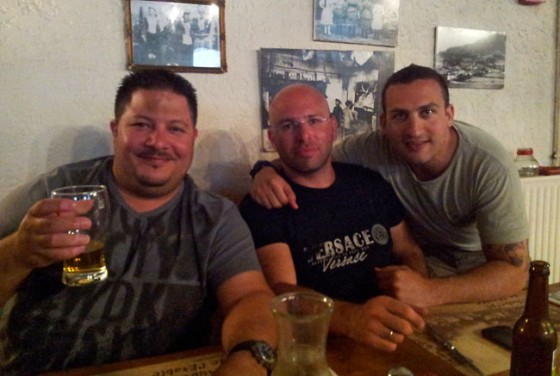
Beers at Auberge de l’Etable after a good day’s biking…
Unfortunately the lads had to ride back to Madrid the next day, but I was about to get stuck into the back roads of the Basque Pyrenees.
Day 5. Six Cols Around Montory & The Basque Pyrenees
Distance – 203km
The route I took this day was only 200km but takes a solid 6-7hrs. Don’t let the maps fool you. The back roads in this area may be well surfaced for the most part but they are incredibly narrow (about the width of a car), very steep in many places and have an endless supply of 90 degree turns. I really would not want to be up here wrestling with the likes of a Goldwing.
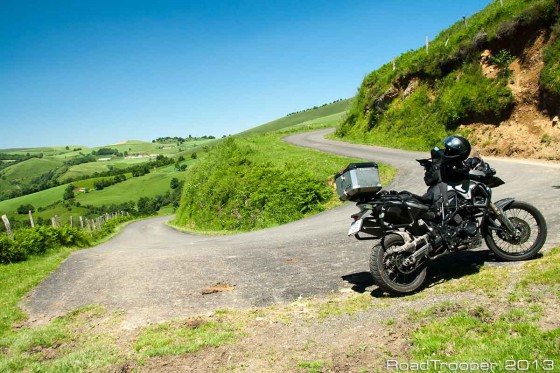
Near Col d’Haltza
The F800GS had little difficulty on most of the hairpins, and the wet clutch proved it’s worth a hundred times this day. I met a lad on a Triumph Tiger 800 at one stop off during the day who said the Tiger was a perfect tool for these roads. He certainly seemed to be enjoying himself as he made headway while I was forced to take a slower pace on the endless steep hairpins. But there is no way an F800GS could keep up with a Tiger 800 on any good road anyway.
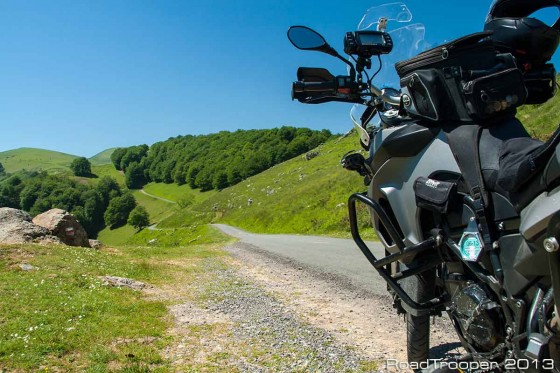
Somewhere in the Basque Pyrenees
While the roads in this area have a unique quality – I don’t think I got above 3rd gear for 90% of it, the scenery is absolutely mind bending. There is nothing else like it in Europe, you really must come here.
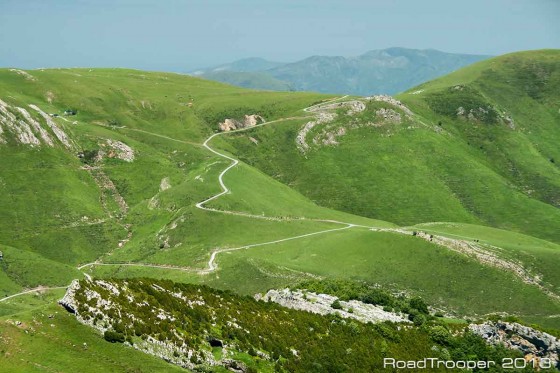
View from the D-301. There are hundreds of kilometers of tiny roads up here…
The roads themselves are mostly farmers’ trails that have been paved over, but many are pilgrim paths and part of this route takes in a small section of Camino de Santiago de Compostela. You will often see signs for this legendary route here, either modern signs or ancient shell designs (the symbol of St. James) carved into rocks.
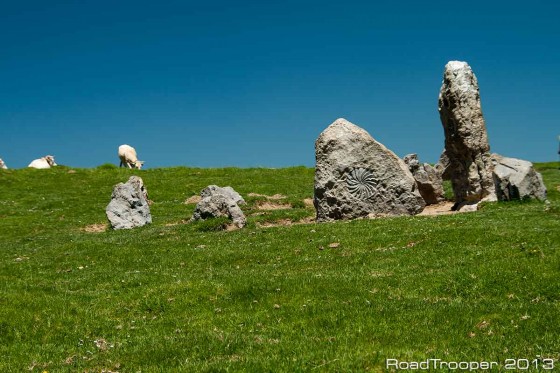
The D428, Basque Pyrenees. Basque Sun Symbol carved into a rock and part of a stone circle.
Place names in this area are mad too, passes on this route have names like Cols Héguichouria, Bagargiak, Burdincurutcheta, Orgambidesca, Col d’Haritzcurutche and Col de Burdincurutcheta, these are Basque names and seem a bit mad. Actually though I learned the Basque language is particularly phonetic, so with a little practice and concentration it is possible to get your tongue around those names.
If planning this route make sure to fill your tank and check the weather forecast before setting off. Even if the weather looks good, due to this areas proximity to the Atlantic to the west, France to the north and Spain to the south the weather can change frighteningly quickly. So be prepared! On this day it was 24C and very humid, between that and the slow going roads I was working hard, so bring plenty of water and energy bars/lunch as there are no shops up here.
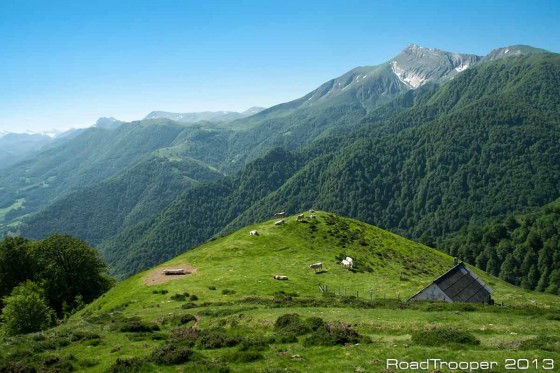
Col d’Haritzcurutche
A detailed paper area map is also a good idea, while I had a SatNav it regularly lost it’s signal as the valleys are deep while the mountains are incredibly steep blocking the SatNavs sight to satellite. I find the Michelin Maps the best to use for this area as it’s a rabbit warren of tiny roads, tracks and trails and the AA amongst others don’t seem to map these roads so well.
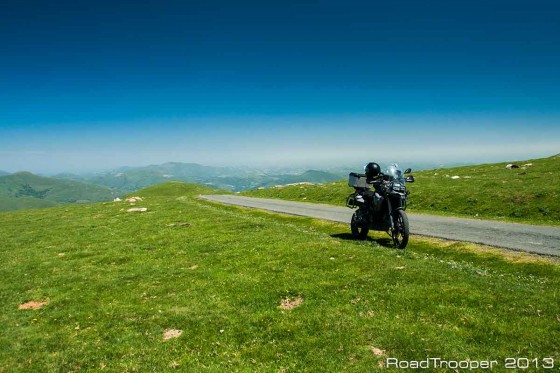
On top of the Basque world…
All that might sound like a bit of a hassle, but it’s well worth the effort for the experience and scenery alone, it is hard to describe, just take my word on it and put this area on your to-ride list.
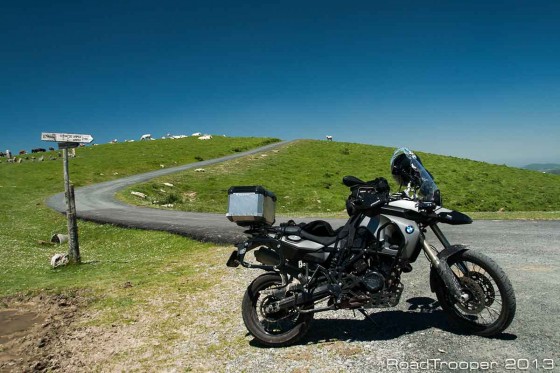
I’ve no idea where this was taken, many roads up here are unmarked. Even with maps and a SatNav I still ended up using a compass to figure out which direction I was heading.
If you decide to stay in Montory’s Auberge de l’Etable the owner, a registered rally driver also runs 4X4 off road days into the more serious back country trails if you want to keep the adrenalin pumping but fancy a day off the bike.
Coming next is my September trip log, a long overdue return to Route des Grandes Alpes »
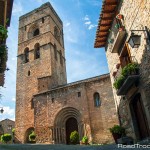
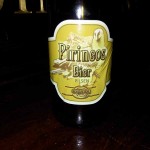
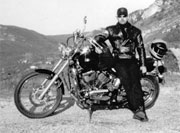







Hi Denis, sorry for write in spanish but my english is very poor.
Muchas gracias por compartir tus experiencias. La primera semana de Septiembre haré mi primer viaje en moto a Pirineos. Espero que me haga buen tiempo y ver los estupendos paisajes que se ven en tus vídeos. Las rutas serán:
http://binged.it/1j571fD
http://binged.it/1j4BVoe
http://binged.it/1j3YauJ
http://binged.it/1j3XfdN
http://binged.it/1j57hLJ
http://binged.it/1j4x2M3
Como una de mis aficiones es la fotografía (algo abandonada ahora) y cuando voy con la moto tengo que parar continuamente a sacar fotos, me decidi al ver tus videos a comprar una cámara, la estrene en Mayo en un viaje a la Sierra de Grazalema (Cadiz).
https://vimeo.com/eppursimuove/videos
Si tuviera que destacar algun paisaje, la bajada del Puerto de Las Palomas, precioso paisaje.
https://vimeo.com/98860973
Gracias de nuevo por compartir tus conocimientos.
V’s
Ola,
Thanks for the links, I really enjoyed your video channel, those roads near Cadiz looked amazing. Maybe later this year I’ll find time to visit them myself as I will be back in Murcia at the end of September.
I will also be in the Pyrenees in September but it will be the 2nd or 3rd week before I am there. Here is my route for my September trip http://tinyurl.com/qyhojtm
Here is my route for my September trip http://tinyurl.com/qyhojtm
Best regards
Denis
WOW¡¡
This is a great route. I see that you go to Asturias. I was in 2013 with the bike (in car other years)
http://debates.motos.coches.net/showthread.php?317498-Asturias-2013
If not known, should go to Tresviso.
http://goo.gl/maps/atDYJ
V’s
Orlando
Thanks Orlando, that looks like a good route, I might get to try it in September..
Denis
Hi Denis ¿Qué tal tu viaje? Espero que hiciera buen tiempo y todo fuera perfecto. El mio fue simplemente soberbio. Un tiempo magnifico y unos paisajes increíbles.
http://debates.motos.coches.net/showthread.php?320984-Pirineos-2014-(otro-pesao-mas-con-sus-fotos)
https://vimeo.com/album/3048415
Col de Tentes, Cirque de Troumouse, la Bonaigua, Tourmalet, Cóth de Varradós, Superbagneres, Lac de Cap de Long etc, etc, etc. ¡¡¡¡Quiero volver¡¡¡¡¡
Hi Denis.
Thank heavens I found you! Followed a link from your great clips on YouTube.
I live just north of the border near Newcastle, Co. Down and while I’ve made trips to the mainland many times and often head south, I’ve never got to Europe on two wheels in 40+ plus years motorcycling. Family, work, etc.
I do the Irish Photo Rally and, like yourself, try to take a decent snap now and again.
Well, at the end of August this year, me and my mate are taking the ferry from Rosslare to Cherbourg for ten(ish) days, heading towards the Pyrenees and your routes and touring guide are perfect for what we need.
Although, those Guardia Civil sound a bit scary to deal with!
And now I know what’s wrong with my dry eyes and cramps in the legs. Too much coffee and not enough water. I thought it was because I turn 60 in January!
That’s the super scooter put back for another few years.
I will of course, be taking plenty of photos and I’ll try to keep a written record of the trip for your website, too.
My mate is on a KTM 1190 I’m on the accursed R1200GS TC.
I felt the same about them. Bit like ar_eholes, everyone seems to have one. But they are a great all round tourer. More suitable than what I changed from three months ago, a BMW K1600GT. Awesome bike, but my legs are too short.
If you don’t mind, I was going to recommend your site on another forum that I have been a member of for seven or eight years, the K100-forum.com.
Think some there might appreciate your experiences.
Hi John,
Thanks for the mail. Best of luck with your 1st ride to the Pyrenees, your going to love it, hopefully it will be the 1st of many such trips. Don’t be worried about the Guardia Civil, as long as you are not breaking any laws they’ve no reason to stop you. You’re only likely to see them at the major border crossing’s anyway. August will be seriously hot, temps were already hitting the high 30′s when I was in Navarra and Basque Pyrenees 2 weeks ago, expect 40C in August, so be sure of plenty of stops to stay hydrated as altitude also increases the rate of dehydration. Before you go drop into your local sports shop and pick up some hydration tablets which you drop into your water, this will help replace your body salts/minerals/electrolytes which are lost through sweat which will then keep your energy and attention levels up. Feel free to recommend this site to any forums, we might choose to ride different machines but we’re all bikers
Be sure to let us know how you got on,
Stay safe,
Denis
Heading down to get the boat to Cherbourg from Rosslare next Saturday, the 29th September.
Intend to get as far south as we can on the Sunday, stop for the night and then make our way into the Pyrenees on the Monday morning.
Going to spend the week exploring then back up the French coast starting on the Friday in time for the boat on Sunday afternoon. Only have the eight days to spare this time.
Can you recommend anywhere to stay on the Sunday night somewhere north of the Pyrenees? Want to book ahead as its a big journey first day.
No five star hotels, please. We’re too tight for that!
Intend to just wing it for accommodation for the week after that, as per your excellent touring virgin’s guide.
Maybe thats something you could add to your site, recommended places to stay.
Any other advice would be useful.
Hi,
You could try Logis Le Relais De Touventry in Boutenac (https://goo.gl/maps/sQ9XF) (https://www.booking.com/hotel/fr/le-relais-de-touvent.en-gb.html?aid=304142;sid=67692abdfb1d122e2c00a412b363e89d;dcid=2#map_closed)
or
Hôtel Restaurant Le Commerce in Saujon (https://goo.gl/maps/2UV7E) (https://www.booking.com/hotel/fr/sarl-ninou-restaurant-le-commerce.en-gb.html?aid=304142;sid=67692abdfb1d122e2c00a412b363e89d;dcid=2#map_closed)
Both are are about 30-45mins north of Bordeaux – a 6-7hr ride from Cherbourg and 3-4hrs from the Pyrenees. I’ve stayed in both and are fine for a 1 nighter..
Safe riding, have a great trip..
Denis
Hi Denis.
Just a few lines to say thanks for the great advice as a tour virgin.
Had a good trip at the start of September and based some of our route on your May 2013 Pyrenees trip.
One thing you should add to your guide is to choose your travelling companions carefully. No real dramas, but I think I’ll be going back to being a lone rider for next year. Makes life so much less complicated plus, I like meeting new people.
I’m already starting to plan next year’s trip and really looking forward to it.
Took a few videos while I was there. I’m sure much of it will look familiar to you.
Used my fabulously expensive Xiaomi Yi, a Go Pro clone. £69 including a spare battery!
Here are the links.
https://vimeo.com/139636798
https://vimeo.com/140360996
Hi John, thanks for writing in, good to hear the tour guide was of help. As for travel companions or group riding there really are two frames of thought on this. Simply put riding in groups is not for everyone, hence the lone rider or “lone wolf”, it all boils down to a very different travel experience and how independent the rider is in general. When I have my tour guide hat on I enjoy riding/leading in a group for the craic off the bikes, but if I’m going on a trip or holiday for myself I most definitely prefer to do it on my own, or with only one or two very like minded close friends with similar riding styles and interests. It sounds like you may well have the personality type that likes exploring what you want, when you want and at your own pace, and if you make friends/acquaintances easily then taking a trip solo may be your best option. Ye’ll not know ’till you try it
Thanks for the video links, I enjoyed that..
Safe riding John,
Denis
Denis hi,
Another Israeli following your trails:) After reading this & the washout post, I was wondering if there’s any method to distinguish car-appropriate (vs. bike) roads in the Pyrenees area. I travel by car, and some of the paths in your trip seem a bit too narrow for what I’d attempt..got any tips?
Hi Yoni
I guess all surfaced roads are car appropriate in the Pyrenees and even many of the unsurfaced ones. Most of the really narrow roads are found around the Basque/Atlantic side, it’s not really a problem, you just have to drive slower and be very careful of oncoming traffic on blind corners. Also be aware that cows, horses etc can be on the road as they are free to roam.
There’s usually plenty of places to safely pull over to the side of the road for passing but outside of the tourist high season of July and August there really is not much traffic anyway so I’d not be worried about it as long as your not driving a 12 bed camper van/RV Just give yourself loads of time, don’t drive too fast and you’ll get used to it after the 1st day..
Just give yourself loads of time, don’t drive too fast and you’ll get used to it after the 1st day..
Denis
Thanks Denis! Appreciate your feedback